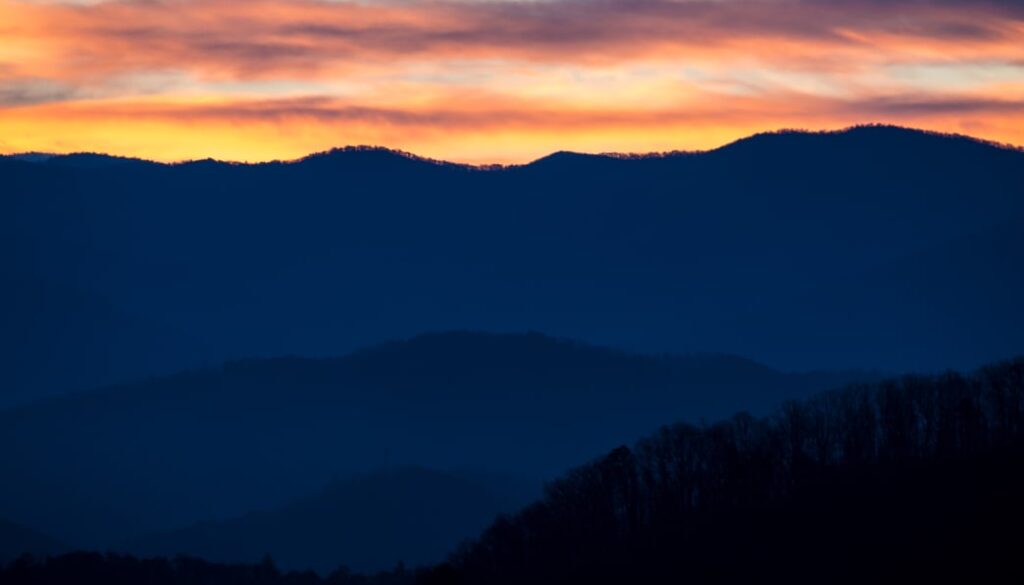A Guide to the Great Smoky Mountains National Park
Planning a trip to the Great Smoky Mountains can be as overwhelming as it is exciting. If you’ve never been to the park yourself, you’ve probably seen pictures of peaceful, rhododendron-flanked rivers, eye-popping springtime wildflower displays, and the beautiful warm colors of autumn that nestle down on these mountains come October.
The idea of the Smokies is exciting, but when you actually pull out the map and try to plan a trip, it can be, well, really daunting. That’s why we’ve broken the park up into a few smaller, more manageable chunks to help you plan the trip that’s right for you.
Best All-Around (West Side of the Smokies)

Charlie Choc
If you’re looking to dip your toes into the Smoky Mountain experience, the west end of the park via Townsend is the best way to do it. Because of its lower elevation and relatively flat roads and trails, this part of the park has the most year round use. Included in this part of the park is Cades Cove, which is home to historic structures like the old Missionary Baptist and Methodist churches and the John Oliver Cabin, all remnants from the days when the cove was home to a small community of settlers before the founding of the national park.
You’ll also find the trailhead toAbrams Falls, one of the most popular waterfall trails in the park, as well as the beautiful Rich Mountain Loop Trail. Unfortunately, the popularity and easy access of this part of the park means you’ll be navigating larger crowds and standstill traffic on Cades Cove Loop throughout the spring and summer months, but cyclists and pedestrians can experience the circuit more serenely by getting up a little earlier. Every Wednesday and Saturday from May until late September, the loop road is closed to all motor vehicles before 10am, allowing pedestrians and cyclists to enjoy the loop without the frustration and danger that comes will navigating around cars.

Kevin Stewart
But don’t think this end of the park is all rolling hills and tourists. Nearby Abrams Creek has class III and IV paddling, and one of the highest points in the park, Rockytop/Thunderhead Mountain , is accessible from the Cades Cove campground.
The Climbs (Central Smokies)
US-441 traces its way through the middle of the Smokies, and is speckled with some of the steepest, most difficult, and awe-inspiring climbs in the park. The Chimney Tops , LeConte , Charlies Bunion , and Andrews Bald all have trailheads along this road, and visitors will also find the scenic vistas of Newfound Gap and Clingman’s Dome off 441 before it snakes further southeast to the park border at Cherokee, NC.
If you’re looking for an exhilarating hike, beautiful views, and an intense workout, this is probably the part of the park you want to be in. But it’s also the part of the park with the shortest open seasons. Late springs and early winters mean unpredictable road closures from October all the way into early May, So always make sure you check road conditions via the GSMNP twitter page, to see if your next scheduled adventure is accessible and safe.
The Gatlinburg Escape (North end of the Park)
Even big fans of Gatlinburg can appreciate that beautiful moment on the road toward the mountains when the museums, restaurants, and boutique shops of the city yield to trees and streams and rivers. The northern end of the park near Gatlinburg is home to several popular Smokies experiences. West of Gatlinburg along Little River Road you’ll find easy access to Laurel Falls, Metcalf Bottoms, Cucumber Gap, and Jakes Creek. Make sure you also stop in at Elkmont to see the (not-so) abandoned town that inspired this viral video. East of Gatlinburg you’ll find the trailhead for Ramsey Cascades and Porters Creek, the latter of which boasts arguably the best wildflower display in the park.
Underrated (Eastside)
Less frequented by Knoxvillians because of its distance from the city center, this area is perhaps most well known for Max Patch , which, while not actually within the boundaries of the park, is still well worth a visit. Ashevillians will likely be much more aware of what this side of the park has to offer, including the Big Creek Campground , which is a great base camp for explorers looking to experience popular swimming destination Midnight Hole and fire tower-topped Mt. Sterling . Daring kayakers will enjoy paddling down Big Creek , while less experienced floaters will be better off opting for a float down Pigeon River .

Logan Mahan
Obviously, 800 words isn’t going to provide an entirely exhaustive guide to America’s most visited national park, but it should help give you a working idea of which areas of the park meet the needs of your next big Smoky Mountain adventure.
For hikers, we suggest the National Geographic Map of the Great Smoky Mountains, and Dayhikes of the Smokies by Carson Brewer to get a full scope of what the park has to offer. Kayakers should check out Kirk Eddlemon’s new two-volume guidebook, Whitewater of the Southern Appalachians.
And remember: No dogs allowed on any trails in the park and permits are required for backcountry camping.
Written by Logan Mahan for RootsRated.
Featured image provided by Stewart Photography




